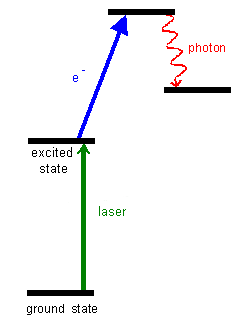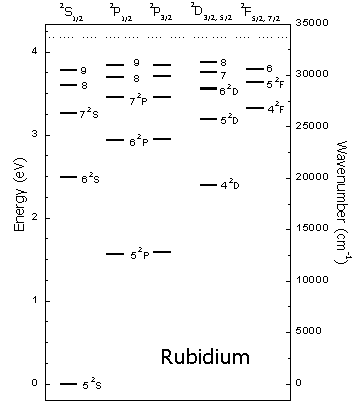Electron-impact Excitation of Laser-excited Atoms
2nd Generation Magneto-Optical Trap (MOT) experiment

Atom Traps are a source of excited atoms
The trapping lasers in a MOT are tuned to be slightly below the Rb (52S1/2 to 52P3/2) resonant transition frequency. The atoms are brought more into resonance by either drifting away from the center of the trap (via the Zeeman-shift induced restoring force), or by moving towards one of the six counter propagating laser beams (via the Doppler-shift induced damping force). Nonetheless, at any given time, a large fraction (~20 to 50%) of all the atoms in the trap are in the laser excited 52P3/2 level.Electron excitation of laser excited atoms
Similar to our work on metastable atoms, we wish to study collisions between the laser-excited Rb atoms and a mono-energetic electron beam that excite the atoms into higher lying energy levels. Atoms excited to these higher levels are detected by monitoring the fluorescence given off by the atoms as they decay back down to lower levels. To remove the contribution from excitation of the 52S½ ground state atoms in the trap, we momentarily turn off the trapping lasers. The atoms remain trapped (for a short time), but none of the atoms are excited to the 52P3/2 level. The difference in signal rates between the two experiments (with some further corrections)is due to the excitation from the laser excited level. For more information on measuring electron-atom collision cross sections with an atom-trap, look at
our First Generation Atom-Trap Experiment. For further information on atom traps and other less
noble measurements, visit the Atom Trainers.
For more information on measuring electron-atom collision cross sections with an atom-trap, look at
our First Generation Atom-Trap Experiment. For further information on atom traps and other less
noble measurements, visit the Atom Trainers.
Some experimental specs:
| Atoms in Trap: | 106 atoms at 100 µK |
| Electron Energy Range: | 0 to 500 eV |
| Electron Beam current: | 150 µA at 100 eV |
| Atoms studied: | working on Rb (52P) -> Rb(52D) |
Recent Published Results
none yetback to experiments list... back to home page